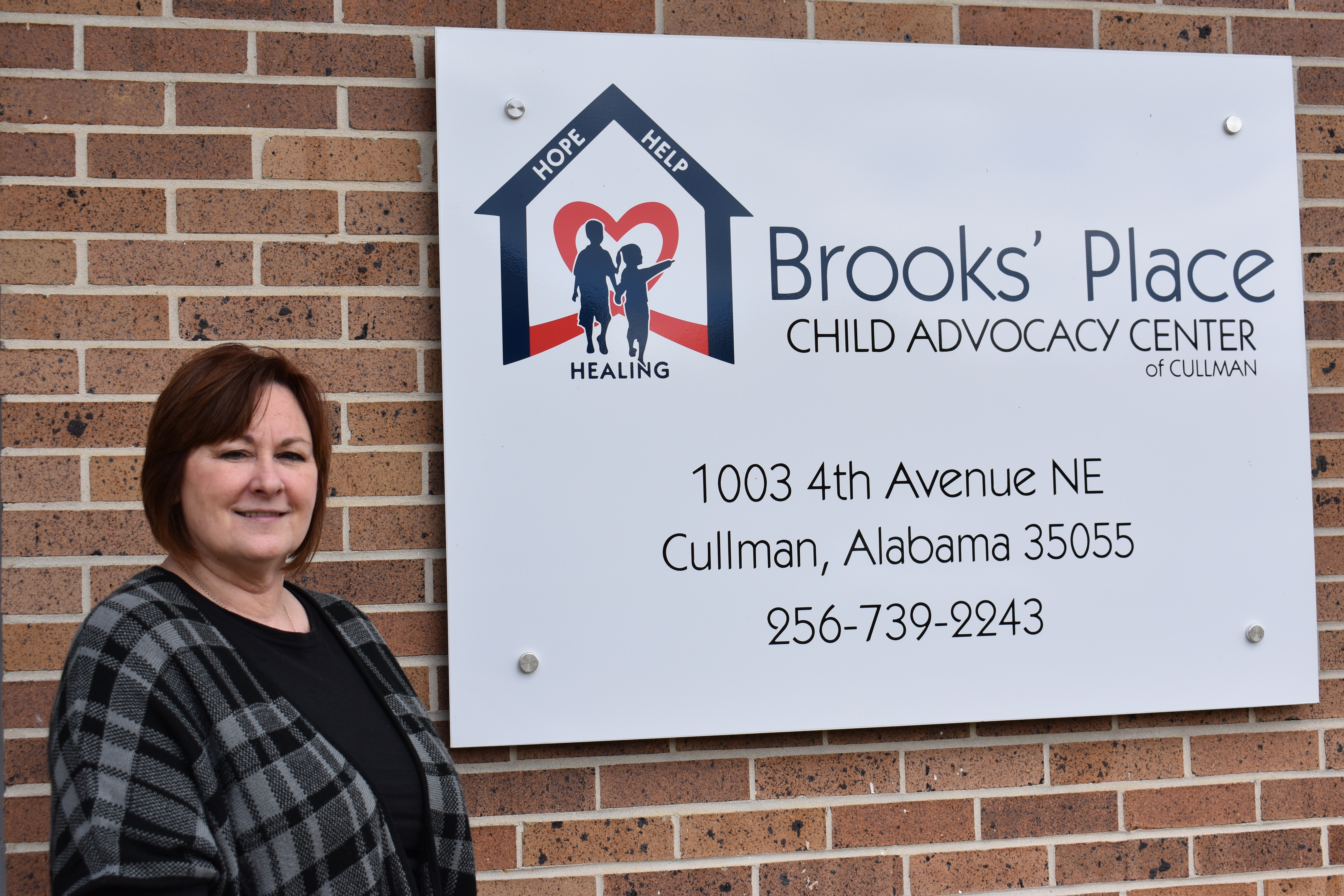Brooks’ Place Child Advocacy Center Director Gail Swafford (W.C. Mann for The Tribune)
CULLMAN – Tucked away on a quiet side street not far from Cullman High School is the office of an organization most Cullmanites know little about. Most folks have heard the name Brooks’ Place, but even after 20 years of service to the community, many aren’t aware of the powerful role the group plays in the lives of Cullman County’s children.
Brooks’ Place is actually Brooks’ Place Child Advocacy Center, a place where children who are victims of physical or sexual abuse can come for help. Once through the door, kids receive a forensic interview in a comfortable setting (no white walls and big tables; it’s kid-friendly, with furniture and accessories to accommodate young children to teens), observed via video cameras by law enforcement and Cullman County Department of Human Resources (DHR) representatives who form part of the center’s Multi-Disciplinary Team (MDT). Children can also receive free non-invasive medical examinations including testing for HIV and sexually transmitted diseases, and free counseling from certified center staff. Brooks’ Place has assisted victims and non-offending caregivers in getting protective orders against offenders and has provided other services for victims and families headed to court.
Brooks’ Place recently celebrated 20 years of child advocacy service in the Cullman community. Over the years, it has grown to become something approaching a one-stop center for child victims and their caregivers. The on-site medical services are a recent addition to the program, a great improvement over the days when victims would routinely have to travel as far as Huntsville or Birmingham for exams.
Medical services are provided by a staff nurse who also has degrees in forensic science and criminal justice.
“Each child who comes here is offered a medical exam,” said Brooks’ Place Director Gail Swafford, “whether or not they disclose abuse or not, because we want to make certain that any unmet medical needs are identified, and then we can make the appropriate referral.
“The other part of that, though, is if there has been sexual abuse or physical abuse, she (the staff nurse) specializes in that. She has specific lighting that can show old bruises, for example, that’s not visible to the naked eye, but she can also do the medical exams to make sure that the child’s body is not hurt in any way, but also, if need be, collect forensic evidence. She can also go to the jail to collect evidence from the offender, and she has done that before.”
Also relatively new to Brooks’ Place is an outreach program headed up by Kaylee Proctor. Under a nationwide legislative movement known as “Erin’s Law,” public schools in more than 30 states are required to provide age- and developmentally-appropriate education to students about recognizing sexual abuse and how to report it, training for faculty and staff on dealing with abuse issues and victims, and both training and support for parents and guardians on recognizing signs of abuse and finding resources to help the victims. After Erin’s Law was passed in Alabama, Brooks’ Place began going out into local schools to offer the program.
Proctor told The Tribune, “Erin’s Law allows us to go into the schools and do sexual abuse prevention education for the kiddos. We do kindergarten, third grade, seventh grade in all of the Cullman County and Cullman City schools. It allows us to teach them body safety, internet safety skills, not just ‘stranger danger’ and fire safety. It’s so many more important things we need to teach them about ways to keep themselves safe.”
In its first year of outreach under Erin’s Law, Brooks’ Place made in-school presentations to 2,665 students, plus parents and school faculty. Similar programs are also available for older students but are administered through the office of District Judge Kim Chaney or the Juvenile Probation Office.
Said Swafford, “I think the public is learning more about us because of the outreach and going into the schools, because that’s a big thing to me, is prevention. When (Proctor)’s going into the schools, she is teaching them that it’s nothing to be ashamed of, it’s okay to tell somebody that you trust, because many times an offender has already convinced them that what they’ve done is wrong and they’re going to get in trouble. So a big thing is ‘It’s never your fault.’
“And we’re developing a relationship with those kids and kind of helping them know what to do, I guess. They don’t have the skills; I mean, they don’t know. That’s the big thing about that.”
The center also offers a program for juvenile sex offenders because, as Swafford explained, “We want those kids, early on, to learn the skills that they need not to do this behavior again. And those are court-ordered, and they’re never on campus at the same time as our other victims.”
Though they don’t see too many of them, Brooks’ Place also welcomes adults who were abuse victims as children.
Brooks’ Place partners with the courts, the Cullman County District Attorney’s office, Juvenile Probation, DHR, the Cullman County Sheriff’s Office, Cullman Police Department, WellStone Behavioral Health (formerly Cullman Area Mental Health Authority), and others to provide an array of services.
“The beauty of that is,” according to Swafford, “it is a partnership. Everyone, the workers in each one of those agencies, works together to provide services for those families.”
The center operates on funding from the Alabama Department of Economic and Community Affairs (ADECA), supplemented by local contributions and donations, and all of its services are provided free of charge to its clients. Last year, Brooks’ Place conducted 265 forensic interviews, and it maintains an active caseload of around 100 clients at any given time, including both victims and some caregivers.
The importance of Child Advocacy Centers (CACs)
Brooks’ Place is one of 35 Child Advocacy Centers in the state of Alabama. In 2017, their staffs and Multi-Disciplinary Teams:
- reviewed 15,979 child abuse/neglect cases
- conducted 8,552 forensic interviews
- referred 1,996 cases for prosecution
- provided 22,630 counseling sessions
Without intervention, counseling and support services, child and teen abuse victims incur an average of $2,635 more annual medical costs than non-victims. As adults they are less likely to own a home, car or stocks, and they earn an average of $8,000 per year less than non-victims.
Areas with easy access to a CAC report felony prosecution rates for child sexual abuse almost three times higher than areas without, and those cases tend to be processed 20 to 30 percent faster than in non-CAC communities.
How does Brooks’ Place determine success?
Swafford said, “One of our goals is focusing on the mental health of the family . . . restoring them to a healthy level of functioning, because it is very traumatic to go through an event like that, especially the parents feeling guilt or whatever. We work with them, too. But I think that’s the measure of success.
“Part of what we’re looking at also is getting justice for that family. That doesn’t always happen, for various reasons. It has to rise to a certain level in the law for us to even get into court. So we don’t judge by the number of convictions, although that is important. It’s more about the kids.
“We work together for the safety of the family, and to provide services for them. That’s success to me, is ensuring that they’re safe and emotionally healthy.”
The final word
“At the end of the day,” said Swafford, “we want these families to be healthy: emotionally, physically. They deserve a childhood, and we want to restore that.
“People say their lives will never be the same. While that is true, it can be better because you can take from that and, for whatever reason it happened, but that’s not a child’s identity. It is an event that happened in their life. So we work from being a victim to a survivor to a thriver, because we never want it to hold them back.”
For more information about Brooks’ Place, visit www.caccullman.org or www.facebook.com/brooksplacecac/.
For more about Erin’s Law, visit www.erinslaw.org.
Copyright 2018 Humble Roots, LLC. All Rights Reserved.



















